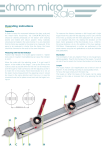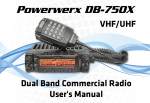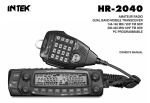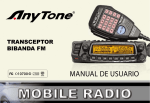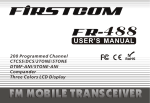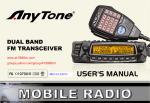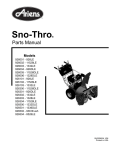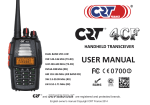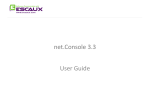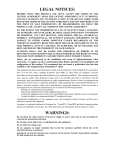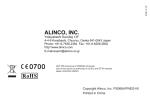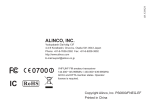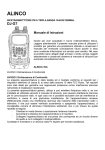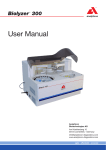Download ALINCO, INC. - Maas Elektronik
Transcript
A1.140422 ALINCO, INC. Yodoyabashi Dai-bldg 13F 4-4-9 Koraibashi, Chuo-ku, Osaka 541-0043 Japan Phone: +81-6-7636-2362 Fax: +81-6-6208-3802 http://www.alinco.com E-mail:[email protected] DR-638HE: VHF/UHF FM amateur transceiver 144.000-145.995MHz/430.000-439.995MHz Use of this device is authorized in all EU and EFTA member states(CH/ICE/LI/NOR). Operator's license is required. Copyright Alinco, lnc. PS0820/FNEH-NI Printed in China VHF/UHF FM Mobile Transceiver DR-638H Instruction Manual Thank you for purchasing your new Alinco transceiver. Please read this manual carefully before using the product to ensure full performance, and keep this manual for future reference as it contains information on after-sales services. In case addendum or errata sheets are included with this product, please read those materials and keep them together with this instruction manual for future reference. Introduction Thank you very much for purchasing this excellent Alinco transceiver. Our products are ranked among the finest in the world. This radio has been manufactured with state of the art technology and it has been tested carefully at our factory. It is designed to operate to your satisfaction for many years under normal use. Please read this manual completely from the first page to the last, to learn all the functions the product offers. It is important to note that some of the operations may be explained in relation to information in previous chapters. By reading just one part of the manual, you may risk not understanding the complete explanation of the function. Before transmitting There are many radio stations operating in proximity to the frequency ranges this product covers. Be careful not to cause interference when transmitting around such radio stations. ■ Lightning Please note that no car provides adequate protection of its passengers or drivers against lightning. Therefore, Alinco will not take responsibility for any danger associated with using its radios or inside the car during lightning. Conformity Symbols Tested to comply MIL-STD-810G -Shock: Method 514.6/I,IV -Vibration: Method 516.6/I CE Conformity Information This device is in compliance with the essential requirements of R&TTE Directive 1999/5/EC. A copy of the certificate by the notified body can be reviewed at http:// www.alinco.com/usa.html. DR-638HE VHF/UHF FM Amateur Transceiver 144.000-145.995MHz/430.000-439.995MHz This device is authorized for use in all EU and EFTA member states. An operator's license is required for this device. Manufacturer: ALINCO, Inc. Electronics Division Yodoyabashi Dai-bldg. 13F 4-4-9 Koraibashi, Chuo-ku, Osaka 541-0043 Japan Check with your local waste officials for details on recycling or proper disposal in your area. WARNING To prevent any hazard during operation of Alinco’s radio product, in this manual and on the product you may find symbols shown below. Please read and understand the meanings of these symbols before starting to use the product. Danger This symbol is intended to alert the user to an immediate danger that may cause loss of life and property if the user disregards the warning. Alert This symbol is intended to alert the user to a possible hazard that may cause loss of life and property if the user disregards the warning. Caution This symbol is intended to alert the user a possible hazard that may cause loss of property or injure the user if the warning is disregarded. Alert symbol. An explanation is given. Warning symbol. An explanation is given. Instruction symbol. An explanation is given. Do not use this product in close proximity to other electronics devices, especially medical ones. It may cause interference to those devices. Keep the radio out of the reach of children. In case a liquid leaks from the product, do not touch it. It may damage your skin. Rinse with plenty of cold water if the liquid contacted your skin. Never operate this product in facilities where radio products are prohibited for use such as aboard aircraft, in airports, in ports, within or near the operating area of business wireless stations or their relay stations. Use of this product may be prohibited or illegal outside of your country. Be informed in advance when you travel. The manufacturer declines any responsibilities against loss of life and/or property due to a failure of this product when used to perform important tasks like life-guarding, surveillance, and rescue. Do not use multiple radios in very close proximity. It may cause interference and/or damage to the product(s). ALERT Environment and condition of use: Do not drive while handling the radio for your safety. It is recommended that you check local traffic regulations regarding the use of radio equipment while driving. Some countries prohibit the operation of transceiver while driving. The manufacturer declines any responsibilities against loss of life and property due to a failure of this product when used with or as a part of a device made by third parties. Use of third party accessory may result in damage to this product. It will void our warranty for repair. WARNING Handling this product: Be sure to reduce the audio output level to minimum before using an earphone or a headset. Excessive audio may damage hearing. Do not open the unit without permission or instruction from the manufacturer. Unauthorized modification or repair may result in electric shock, fire and/or malfunction. Do not operate this product in a wet place such as shower room. It may result in electric shock, fire and/or malfunction. Do not place conductive materials, such as water or metal in close proximity to the product. A short-circuit to the product may result in electric shock, fire and/or malfunction. Do not touch the heatsink (on/around the unit mostly found on mobile-base units) as it may become very hot during/after the operation that may risk burn your skin. About power-supply: Use only appropriate, reliable and certified power supply of correct voltage and capacity. Do not connect cables in reverse polarity. It may result in electric shock, fire and/or malfunction. Do not plug multiple devices including the power-supply into a single wall outlet. It may result in overheating and/or fire. Do not handle a power-supply with a wet hand. It may result in electric shock. Securely plug the power-supply to the wall outlet. Insecure installation may result in short-circuit, electronic shock and/or fire. Do not plug the power-supply into the wall outlet if the contacts are dirty and/or dusty. Shortcircuiting and/or overheating may result in fire, electric shock and/or damage to the product. Do not modify or remove fuse-assembly from the DC-cable. It may result in fire, electric shock and/or damage to the product. In case of emergency: In case of the following situation(s), please turn off the product, switch off the source of power, then remove or unplug the power-cord. Please contact your local dealer of this product for service and assistance. Do not use the product until the trouble is resolved. Do not try to troubleshoot the problem by yourself. • When a strange sound, smoke and or strange odor comes out of the product. • When the product is dropped or the case is broken or cracked. • When a liquid penetrated inside. • When a power-cord ( including DC-cables, AC-cables and adapters) is damaged. For your safety, turn off then remove all related AC-lines to the product and its accessories including the antenna if a thunderstorm is likely. Turn off the unit, remove the mobile antenna from its base and keep it in the vehicle if a thunderstorm is likely. Please read cautions regarding the lightning-protection on page 9 also. Maintenance Do not open the unit and its accessories. Please consult with your local dealer of this product for service and assistance. WARNING CAUTION Environment and condition of use: About power-supply Use only reliable power supply of specific DC output range and be mindful of the polarity of the cables and DC jack. Do not use the product in proximity to a TV or a radio. It may cause interference or receive interference. Always turn off the power supply when connecting or disconnecting the cables. Do not install in a humid, dusty or insufficiently ventilated place. It may result in electric shock, fire and/or malfunction. When using an external antenna, make sure that the antenna ground is not common with the ground of the power supply. Do not install in an unstable or vibrating position. It may result in electric shock, fire and/or malfunction when/if the product falls to the ground. European users: When a transceiver is powered from an external DC power source (adapter, power supply, cigar-plug etc), make sure that this power supply has approval to the level of IEC/EN 60950-1. Do not install the product in proximity to a source of heat and humidity such as a heater or a stove. Avoid placing the unit in direct sunlight. Do not modify, dismantle, incinerate, or immerse the batteries that may be used in accessories you use with this product. Please check your local regulations for details on recycling option or disposal of the batteries in your area. About transceiver Do not connect devices other than specified ones to the jacks and ports on the product. It may result in damage to the devices. Turn off and remove the power-source (AC cable, DC cable, battery, cigar-cable, charger adapter etc) from the product when the product is not in use for extended period of time or in case of maintenance. Use a clean, dry cloth to wipe off dirt and condensation from the surface of the product. Never use thinner or benzene for cleaning. CONTENTS New and Innovative Features...............................................1 Supplied Accessories/Optional Accessories......................2 Supplied Accessories........................................................................ 2 Initial Installation...................................................................3 Mobile installation............................................................................. 3 DC Power Cable Connection............................................................ 4 Power supply voltage Display........................................................... 6 Antenna Connection......................................................................... 6 Accessories Connections.................................................................. 6 Front Panel Separation..................................................................... 7 Getting Acquainted...............................................................8 Front panel........................................................................................ 8 Rear panel........................................................................................ 9 Display.............................................................................................. 9 Microphone ...................................................................................... 10 Basic Operations ..................................................................11 Switching the Power On/Off.............................................................. 11 Adjusting the Volume........................................................................ 11 Squelch level setting......................................................................... 11 Switch between VFO and memory mode......................................... 11 Setting frequency.............................................................................. 11 Setting channel................................................................................. 11 Switch Between Main Band and Sub band....................................... 12 Selecting the operating band............................................................ 12 Receiving.......................................................................................... 12 Squelch Off/Squelch Off Momentary................................................ 12 Transmitting...................................................................................... 12 Transmit DTMF/2TONE/5TONE signaling........................................ 13 High/Mid/Low Power Setting............................................................. 13 Frequency Reverse........................................................................... 13 CTCSS/DCS setting.......................................................................... 13 Call channel recalling........................................................................ 13 CTCSS/DCS Scan............................................................................ 13 Dual Watch....................................................................................... 14 Emergency Alarm.............................................................................. 14 Channel/Frequency Scan................................................................. 14 Channel Scan Skip........................................................................... 14 Memory Channel Programming........................................................ 14 Search Scan Range Setting.............................................................. 14 Channel Copy................................................................................... 15 Channel Delete................................................................................. 15 Memory Banks operation.................................................................. 15 PARAMETER SETTING MODE(SET MODE)........................16 Menu 01: APO (Automatic power off)............................................... 16 Menu 02: Automatic offset................................................................ 16 Menu 03: VFO Channel Step Setting................................................ 16 Menu 04: VFO Band lockout............................................................. 16 Menu 05: Beep Sound...................................................................... 17 Menu 06: CPU Clock Frequency Setting.......................................... 17 Menu 07: 2Tone Encode Select........................................................ 17 Menu 08: 5Tone Encode Select........................................................ 17 Menu 09: Add Optional Signaling...................................................... 18 Menu 10: Tone Encode Setup........................................................... 18 Menu 11: Tone Decode Setup . ........................................................ 18 Menu 12: Sub Band Display............................................................. 19 Menu 13: DTMF Encode Pre-Loading Timing................................... 19 Menu 14: DTMF Encode Transmitting Time..................................... 19 CONTENTS Menu 15: DTMF Encode Setup........................................................ 19 Menu 16: Squelch Mode Setup......................................................... 20 Menu 17: Compander....................................................................... 20 Menu 19: Tone Burst Tones.............................................................. 20 Menu 20: Hyper................................................................................ 20 Menu 21: Keypad Lockout................................................................ 21 Menu 22: PTT Lockout...................................................................... 21 Menu 23: TOT Penalty...................................................................... 21 Menu 24: Frequency Reverse........................................................... 21 Menu 25: SUB Band Mute................................................................ 21 Menu 26: Editing Memory Name...................................................... 22 Menu 27: Time-Out Timer(TOT)........................................................ 22 Menu 28-31: Microphone PA,PB, PC,PD key setup ........................ 22 Menu 32: RF Squelch....................................................................... 22 Menu 33: Offset Direction................................................................. 23 Menu 34: Scan Resume Condition................................................... 23 Menu 35: Priority Channel Scan....................................................... 23 Menu 36: Offset Frequency.............................................................. 23 Menu 37: Display Mode.................................................................... 24 Menu 38: Busy Channel Lockout(BCLO).......................................... 24 Menu 39: DTMF Self ID Enquiry....................................................... 24 Menu 40: 5-TONE Self ID Enquiry.................................................... 24 Menu 41: VFO Frequency Linkage................................................... 25 Menu 42: Wide/Narrow FM Mode..................................................... 25 Menu 44-46: LCD backlight.............................................................. 25 Menu 47: Keypad backlight brightness............................................. 25 Menu 48: Calling Record.................................................................. 25 Menu 49: AM Function...................................................................... 26 Menu 51: VHF External speaker port .............................................. 26 Menu 52: Beep Volume control . ...................................................... 26 Menu 53: Talk Around ...................................................................... 26 Menu 54: Microphone Speaker......................................................... 26 Menu 55: Memory Banks Enquiry..................................................... 27 Menu 56: Memory Banks Linking...................................................... 27 Menu 64: Password Function........................................................... 27 Microphone Operation..........................................................28 Send DTMF signaling....................................................................... 28 Main/Sub band switching.................................................................. 28 Function operation through PA-PD keys........................................... 28 Cable Clone............................................................................30 Resume Factory Default................................................................... 30 Programming Software Installing and Starting..................31 Utility Software in Windows system.................................................. 31 Maintenance...........................................................................32 Trouble Shooting............................................................................... 32 Specifications........................................................................33 Appendix................................................................................34 51 groups CTCSS Tone Frequency(Hz)........................................... 34 1024 groups DCS Code.................................................................... 34 1 New and Innovative Features 758 memory channels. 50 Watts of power output on the VHF band and 40 Watts on the UHF band. UU, UV, VU, VV operations. A large LCD with selectable backlit color, Keys and microphone keypads are also backlit and ensures comfortable operation in the dark. CTCSS, DCS, 2-tones, 5-tones and tone-bursts for repeater access and sellective calling operations. Various scan functions including CTCSS/DCS Scan. 1 Variety of signaling such as emergency alarm, ANI/DTMF, remotekill/revive features. Compander function to decrease the background noise and enhance audio clarity. Wide and Narrow-FM modes supported. (25KHz/20KHz/12.5KHz) Theft alarm provides extra safety. Supplied Accessories 2 Supplied Accessories Carefully unpack to make sure the following items are found in the package in addition to this manual: Transceiver DR-638 Spare Fuses Microphone EMS-77 (with DTMF keyboard) User Manual Mobile Mounting Bracket DC Power Cable with Fuse Holder Hardware Kit for Bracket Black screws (M4X8mm) 4PCS Tapping screws S-Washer (M5X8mm) 4PCS Mic Hanger Unit 2 The standard accessories may vary slightly depending on the version you have purchased. Please contact your local authorized Alinco dealer should you have any questions. Alinco and authorized dealers are not responsible for any typographical errors there may be in this manual. Standard accessories may change without notice. Warranty Policy: Please refer to any enclosed warranty information or contact your authorized Alinco dealer / distributor for the warranty policy. ■ In order to operate this product, a properly tuned antenna, its feedline with connectors and fixing hardware are necessary. Please consult with your dealer for details. 3 Initial Installation Mobile installation The transceiver may be installed in any position in your car, where the controls and microphone are easily accessible and it does not interfere with the safe operation of the vehicle. If your vehicle is equipped with air bags, be certain your radio will not interfere with their deployment. If you are uncertain about where to mount the unit, contact your vehicle's dealer. 111 Install the mounting bracket in the vehicle using the supplied selftapping screws (4pcs) and flat washers (4pcs). Car body Washer (M5) Tapping screw (M5x20mm) 3 Mounting bracket 222 Position the transceiver, then insert and tighten the supplied hexagon SEMS screws. Double check that all screws are tightened to prevent vehicle vibration from loosening the bracket or transceiver. Caution: Use only the provided screws otherwise you risk damaging the circuit board, components or fall-off of the unit. Determine the appropriate angle of the transceiver, using the 3 screw hole positions on the side of the mounting bracket. Initial Installation DC Power Cable Connection Mobile Operation The vehicle battery must have a nominal rating of 12V. Never connect the transceiver to a 24V battery. Be sure to use a 12V vehicle battery that has sufficient current capacity. If the current to the transceiver is insufficient, the display may darken during transmission, or transmitting output power may drop excessively. 3 555Reconnect any wiring removed from the negative terminal. 666Connect the DC power cable to the transceiver's power supply connector. 111Route the DC power cable supplied with the transceiver directly to the vehicle's battery terminals using the shortest path from the transceiver. Never use the cigarette lighter socket as a DC source. The entire length of the cable must be dressed so it is isolated from heat, moisture, and the engine secondary (high voltage) ignition system/cables. 222After installing cable, in order to avoid the risk of damp, please use heat-resistant tap to tie together with fuse box. Don't forget to reinforce whole cable. 333In order to avoid the risk of short circuit, please cut down connection with negative (-) of battery, then connect with radio. 444Confirm the correct polarity of the connections, then attach the power cable to the battery terminals; red connects to the positive (+) terminal and black connects to the negative (-) terminal. Never remove the fuse holders from the cable. Red Black DC power cable Ext. Power jack Press the connectors firmly together until the locking tab clicks. If the ignition-key on/off feature is desired(optional feature), use 4 the optional EDC-43(For Cigar-Plug connection) cable. Connect one of the cables between the ACC terminal or a Cigar-Plug that operates with the vehicle ignition or ACC switch on the vehicle and EXT POWER jack on the rear side of the unit. 777When the ignition key is turned to ACC or ON(Start) position with the radio turned off, the power switch illuminates. The illumination will be turned off when the ignition key is turned to the off position. To turn on the unit, press the power switch manually while it is illuminated. (While ignition key is at ACC or ON position) 888When the ignition key is turned to ACC or ON position with the radio's power switch on, the unit turns on automatically and the power switch will be lit. Turn the ignition key to OFF position or manually turn the power switch off to shut down the radio. 999Use of ignition-key ON/OFF feature drains 5mAh of current from the battery as long as the EDC-43 is being connected. 3 Initial Installation ACC terminal Cigar-Plug connection Optional EDC-43 required 222Connect the transceiver's DC power connector to the connector on the DC power cable. Press the connectors firmly together until the locking tab clicks. Before connecting the DC power to the transceiver, be sure to switch the transceiver and the DC power supply OFF. Do not plug the DC power supply into an AC outlet until you make all connections. Ext. Power jack Fixed Station Operation 5 In order to use this transceiver for fixed station operation, you will need a separate 13.8V DC power supply (not included), Please contact local dealer to require. The current capacity of your power supply must be 12A or more. 111 Connect the DC power cable to the regulated DC power supply and ensure that the polarities are correct. (Red: positive, Black: negative). Never directly connect the transceiver to an AC outlet. Use the supplied DC power cable to connect the transceiver to a regulated power supply. Do not substitute a cable with smaller gauge wires. REPLACING FUSES If the fuse blows, determine the cause, then correct the problem. After the problem is resolved, replace the fuse. If newly installed fuses continue to blow, disconnect the power cable and contact your dealer for assistance. Fuse Location Transceiver Fuse Current Rating 15A Supplied Accessory DC power cable 20A Only use fuses of the specified type and rating, otherwise the transceiver could be damaged. Regulated power supply Red Black DC power cable with fuse holder If you use the transceiver for a long period when the vehicle battery is not fully charged, or when the engine is OFF, the battery may become discharged, and will not have sufficient reserves to start the vehicle. Avoid using the transceiver in these conditions. Initial Installation Power supply voltage Display After connecting the transceiver to the power supply, long press the key, enter Menu 12: Sub Band Display menu, and select DC-IN, then it will appear current power supply voltage on the right side of Screen. The display immediately changes as the voltage supply changes, It also displays voltage during transmission. Important The range of displayed voltage is from 8V to16V DC. Because the displayed value is estimated, please use a voltmeter when a more precise reading is desired. 3 Accessories Connections External Speaker If you plan to use the optional external speaker/s, There are 2 options. For a single speaker, plug into the 3.5mm SP Jack on the rear of the radio to hear both bands through one speaker. To use dual speakers, use the stereo plug it into the 3.5mm ST Jack on the rear of the radio to split the left and right bands between the 2 speakers. External speaker Antenna Connection Before operating, install an efficient, well-tuned antenna. The success of your installation will depend on the type of antenna and its correct installation. Use a 50Ω impedance antenna and low-loss coaxial feed-line that has a characteristic impedance of 50Ω, to match the transceiver input impedance. Coupling the antenna to the transceiver via feed-lines having an impedance other than 50Ω reduces the efficiency of the antenna system and can cause interference to nearby televisions, radio receivers and other electronic equipment. Transmitting without first connecting an antenna or other matched load may damage the transceiver. Always connect the antenna to the transceiver before transmitting. All fixed stations should be equipped with a lightning arrester to reduce the risk of fire, electric shock, and transceiver damage. 6 Microphone For voice communications, connect a provided microphone into the socket on the front of the main unit. Turn the ring firmly on the plug until it locks. Attach the supplied microphone hanger in an appropriate location using the screws included in the screw set. Microphone connector 3 Initial Installation Front Panel separation Microphone Antenna The main unit can be set with either side facing up. This can facilitate your ability to hear the speaker clearly. Position the front panel as you prefer. 111 Slide the front panel while keeping the tab pressed. Main unit Front panel External Dual Speakers (3.5mm Stereo Out) External single speaker (3.5mm Mono Out) Tab 222 Turn the front panel, being careful to keep the cable free from kinks. After installing your antenna, ensure that you have the best possible SWR reading. 7 IMPORTANT: RF Hazard Warning The electro-magnetic exposure of this device may exceed the European standards of the hazard level when transmitting at the high-power setting while connected to a unity gain antenna at a distance of 63cm or less from the operator. Furthermore, the hazardous RF exposure level depends on the conditions of the combination of the antenna gain, distance from the operator, output setting and installation environment, therefore the operator may be exposed to stronger RF even at a distance of more than 63cm. For safety purpose, it is recommended that the antenna be installed outside of, and as far as possible from, the operator’s area. Avoid using an excessively high-gained antenna in case the distance between the operator and the antenna is very limited. Always use the minimum necessary output power for communications. 333 Match the catch in the main unit with the slot in the front panel and fit the front panel into the main unit. Catch Slot 444 Slide the front panel until it locks securily in place. By using the optional separation kit EDS-28, you can use the front panel and the main unit in separate positions. The instruction manual for remote placement is provided with the EDS-28. Getting Acquainted Front panel 4 Short press: Switches to CALL channel. 7 [CALL] 8 [MHz] Long press: When channel setting DTMF/5 Tone, press this key can edit ANI code calling. (microphone input) Short press: Changes frequency step by 1MHz in VFO mode. Long press: Open the frequency reverse function. Short press: Sets CTCSS and DCS values. Basic Functions NO. KEY 9 [TS/DCS] 10 [H/L] FUNCTION Long press: When channel setting CTCSS/ DCS, long press this key to open CTCSS/DCS frequency scan. Short press:Switches the output power in 4 levels. Long press:Open the emergency alarm function 1 PWR(Power) Press it to power On/Off the transceiver. 11 LED indicators 2 Main AF knob Sub AF knob Adjust Main band audio level.( Left ) Adjust Sub band audio level.( Right ) 12 [SCAN] 3 Main SQL ring Sub SQL ring Adjust Main band squelch level.( Left ) Adjust Sub band squelch level.( Right ) 13 [MONI] Dial Knob Rotate it to choose frequency/channel. Press it to set the left band as "Main Band". In function setup, it works as confirm key. in scan mode, rotate it to change scan directions. Long press:Opens squelch and cancels TSQ/DCS temporary. 14 MIC Connector Connect the mic connector or data reading/writing, cloning. 15 LCD Display Displays frequencies, channels and other operating parameters. 4 5 FUNC/SET 6 [V/M] Short press: Function Key Long press: Enter Function Menu setting Short press: Switches between VFO mode and memory mode. Long press: Switch VFO working frequency I lluminates red while transmitting, green while receiving signals. Short press: Starts scanning. Long press: DTMF/2TONE/5TONE setting. 8 4 Getting Acquainted Functions which can be activated while Key 1 MW FUNC+V/M appears, after pressing the 2 DEL FUNC+CALL Delete settings. FUNC+MHZ FUNC+TS/DCS Changes shift directions. 4 SHIFT LOCK Blocks the keys and dial operation 5 PRI FUNC+H/L Enters to the Priority monitor. 6 SKIP FUNC+SCAN Sets scan skip channels FUNC+MONI Setting memory banks. 2 5 3 NO. KEY 2 FUNCTION To Connect optional cable for ignition key On/ Ext. Power Jack Off function. Ext. Dual Speakers To conect external stereo speaker. 3 Antenna Connector 4 Ext. Single Speaker To conect external mono speaker. 5 Fan Connect a 50Ω antenna. Automatically turns on at 45℃, and turns off when it cools down. 3 4 5 6 7 8 13 9 14 10 15 11 1712 19 20 18 16 21 NO. KEYÅ 4 9 1 2 25 Rear panel 1 1 Programs the data into the memory. 3 7 DISPLAY 22 23 24 26 25 27 FUNCTION 1 Appears when press FUNC key. 2 Appears while in AM mode. 3 Appears while using Middle output power. 4 Appears while using low output power. 5 6 Appears while channel setting in narrow band. Appears while channel setting in offset direction. Appears while channel setting in CTCSS encoding and decoding 7 8 DCS 9 COMP 10 11 REP 12 13 SUB 14 Appears while channel setting in DCS encoding and decoding. Appears while channels setting in voice companding. Appears while open key lock function. Not in use. Not in use. Appears while SUB band in Main side. Not in use. Getting Acquainted 15 18 Appears while open grouping function. Appears while Sub side in memory channel or Call channel mode. Appears while Channels setting in frequency reverse function. Not in use. 19 Appears channel frequency or channel name. 20 Appears channel number or grouping number. 21 MAIN Appears while Main band. 22 P1 Appears when current channel is priority channel. 23 P2 24 P3 25 Appears while main/sub receive squelch opened. 26 MAIN:Transmit power indicator/receive indicator. 27 SUB:Receive indicator. 16 17 NO. KEY FUNCTION 1 M/S Switches between Main and Sub bands. 2 Number Key Input VFO frequency or DTMF dial out etc. PA Switches between VFO and Memory modes. PB Changes CTCSS and DCS mode parameters. PC Starts and stops scanning. Transmit preprogrammed DTMF, 2TONE, 5TONE code. The indicator light on for Main band. 3 PD 4 Band Indicator Appears while channel setting in Scan skip. 5 Flash while open Scan. TX/RX Indicator Illuminates red while transmitting, green while (Main/Sub) receiving signals. 6 PTT 7 UP 8 DOWN 9 MIC 10 Speaker microphone 8 9 4 Push-TO-Talk key: Press this key to transmit. Increase frequency, channel number or setting value. Decrease frequency, channel number or setting value. Speak here during transmission. When shut the speaker in the base, you can hear the calling by this speaker. MIC Connector Diagram(in the front view of connector) 1 10 AF out(speaker out) 10 5 Basic Operations Important: The explanations herein are based on manufacturer's default setting. Switching The Power On/Off Setting Frequency Power On Press key to turn on. Appears "ALINCO DR638" then displays current frequency or channel. Power Off Press key for over 0.5 Second to turn off. POWER Adjusting The Volume 11 Rotate the [VOL] knob of selected band clockwise to increase the audio level, counterclockwise to decrease. Rotate the SQL ring counterclockwise to hear the white noise to set the audio level properly. SQUELCH LEVEL SETTING Rotate the [SQL] ring of selected band clockwise to increase the squelch level, counterclockwise to decrease. A noise is heard at the minimum setting. Squelch is to cut the white-noise in stand-by state. Setting it too high may risk missing weaker signals but lower setting may open squelch often hearing more noise. You should set the levels of both MAIN and SUB bands before start operating. Switch between VFO and MEMORY MODE In standby, press or and Memory mode. When in memory mode, the memory channel number appears on the left side of memory frequency. key to switch between VFO(Frequency) In VFO mode, turn the dial clockwise to increase frequency; Counterclockwise to decrease. Every click will increase or decrease frequency by one channel-step. To select MAIN and SUB band, press the dial. Press key then turn the dial or [UP/DOWN] keys to change the frequency by 1MHz step. The microphone [UP/DOWN] key also able to adjust frequency. Press [UP/DOWN] key will increase(decrease) the frequency by one step size. Hold [UP/DOWN] key will adjust the frequency continuously. Input Frequency THROUGH Microphone number key In VFO mode, you can input the frequency by the numerical keys. Out-of-the-band frequnecies are automatically rejected. For example, to input 145.320MHz, press 1,4,5,3,2,0 sucsessively. When completed, a decimal point appears at the MHz order. When the Band lockout function is on, the operating ranges will be limited. Setting CHANNEL In memory mode, you can select the frequency by turning the dial. Turn clockwise to increase, counterclockwise to decrease the channel numbers. To switch the MAIN/SUB band, press the dial. While a memory channel is shown in SUB band, [ ]icon appears. Basic Operations Pressing [UP/DOWN] keys on microphone also sets channels. The mamory channels must be pre-programmed to operate in the memory mode. Empty channels numbers won't be displayed during operation and appears only during memory setting. Input Channel THROUGH Microphone number key In memory mode, pressing 3 numerical keys recalls the desired memory channel. For example press 0,0,1 recalls channel 1. Press 0,3,0 for ch.30, and 5,1,2 for ch.512. If the input channel is not programmed in advance, an error beep sounds and returns to last channel operated. While pressing the key, [CH-] and entering numbers are shown on the display. Switch Between Main Band and Sub band At the default setting, both MAIN and SUB bands are displayed. The transmitting is possible only on the frequency/channel shown on the LEFT. To transmit, press the dial to set the desired frequency or channel on the LEFT side of the display. SELECTING THE OPERATING BAND 111 Select the MAIN band by pressing the dial so that MAIN appears on the left corner of the display. By pressing and holding the key toggles the operating bands between 144-146MHz and 430-440MHz for receiving. 222 Select the SUB band so that SUB appears above the frequency display on the right. By pressing and holding the key toggles the operating bands between 144-146MH and 430-440MHz for receiving. Some restriction may apply depending on the versions. 5 Transmitting is prohibited outside of the specified frequency range. "OFF" appears when PTT is pressed in the RX-only frequency and alarming beep sounds. This transceiver can be set working on 2 UHF band or 2 VHF band. Receiving Both MAIN and SUB bands receive signals simultaneously. While receiving signals, the icon and signal strength icon will appear in the display, and audio sounds. You may risk missing weaker signals when the squelch level is set too high. If the Busy and signal strength icon are displayed but can't hear any audio, please check the selective calling(signaling) setting like Tone-squelch and DCS. Squelch Off/Squelch Off Momentary Press and hold key cancels the squelch and signaling setting temporary to monitor incoming signals of currently operating band. Release the key to activate the squelch and signaling settings. Pressing [ ] key on the microphone functions same as above but holds squelch off until the [ ] is pressed again. Transmitting Before transmitting, monitor the frequnecy to make sure the channel is vacant and won't cause interference to others. 12 5 Basic Operations Hold [PTT] key to transmit, and speak at approximately 5cm/2 inces to the microphone in normal voice level. Too loud or too low voice level may cause trouble hearing at the receiving stations. Transmitting is possible only on the MAIN band. Operating setting can't be changed while transmitting. If the current channel is with DTMF/2TONE/5TONE signaling, hold [PTT] and [ UP ] key will transmit selected Pre-programmed signaling. key to choose output power from 4 different levels. Every Press press of the key toggles the setting as the chart below. The setting is valid until next change in VFO mode, but it holds only temporaly in the memory mode and changing the channel or turning on/off the power will cancel the setting and recalls the original memory parameter of the output power setting. MID1 VHF(25W) UHF(25W) key, When the screen displays the CTCSS frequency and " " icon, rotate band switch or MIC UP/DOWN keys to select key or [PTT] CTCSS encoding which is desired to setting, press key to confirm and exit. 222 Double Press High/Mid/Low Power SETTING HIGH VHF(50W) UHF(40W) CTCSS/DCS SETTING In standby, press key or microphone key can setting the CTCSS/DCS encoding and decoding for current channel. 111 Press Transmit DTMF/2TONE/5TONE signaling 13 This function is valid only when current channel setup with offset frequency and offset direction MID2 VHF(10W) UHF(10W) LOW VHF(5W) UHF(5W) Frequency Reverse In standby, hold key for over 1 second to turn On/Off frequency reverse function. When reverse function is on, the TX frequency will change to RX frequency and RX frequency change to TX frequency. The signaling will also be reversed if CTCSS/DCS signaling existed in this channel. key, When the screen displays the CTCSS frequency and " " icon, rotate band switch or MIC UP/DOWN keys can sync setting the CTCSS encoding and decoding which is desired, press key or [PTT] key to confirm and exit 333 Press key three times, When the screen displays the DCS NO. and "DCS" icon, rotate band switch or MIC UP/DOWN keys can sync select the CTCSS encoding and decoding which is desired, press key or [PTT] key to confirm and exit. CALL CHANNEL RECALLING Press key to recall a preprogrammed channel. It is convenient to set the most frequently used channel in advance as a CALL channel for quicker operation. Repeat it to return to the last operating channel. CTCSS/DCS Scan In standby, long press key to enter CTCSS/DCS scan, when find matching CTCSS/DCS signal, the scan will pause in the scan pause way. In the CTCSS/DCS Scan status, rotate band switch or press the Basic Operations MIC UP/DOWN key can change the scan direction. To enable this function, the channel shall be programmed with CTCSS/DCS decode. Dual Watch In standby, Press and while icon is displayed on the screen, press key to enter Dual Watch mode. The radio will scan the channel in every 5 seconds. When the radio receives matching signal, it pause scanning until the signaling disappear. Repeat above operation to exit Dual watch. Emergency Alarm To start emergency alarm, press and hold key until the transceiver displays ALARM and emit alarm. Re-power on the transceiver to exit alarm. This transceiver has 4 kind of alarm which can be setup by programming software. Channel/Frequency Scan Frequency Scan or key to start scanning. In VFO mode, press the During the scanning, turn the dial or press [UP/DOWN] keys to change the scanning direction. Press [PTT] or keys other than [UP/DOWN] to stop scanning. Channel Scan In Memory mode, press the or key to start scanning. During the scanning, turn the dial or press [UP/DOWN] keys to change the scanning direction. Press [PTT] or keys other than [UP/DOWN] to stop scanning. 5 Channel Scan Skip In Memory mode, turn the dial to choose the channel to skip during and while icon is displayed on the screen, scanning. Press press key. A beep sounds twice and the channel is set as the skip channel and "P2" icon. Repeat it to cancel the setting, a beep is heard once and "P2" icon dissapears. MEMORY CHANNEL PROGRAMMING 111 In VFO mode, select the desired frequency by using the dial or numerical keys. 222 Press key to display and a memory channel number on the display. 333 Rotate the dial or press [UP/DOWN] keys to select a desired 14 memory channel number. 444 While displaying the and a number, press key. MEN-IN appears on the display. While it's displayed, press and hold the key again until a beep is heard and MEN-IN dissapears. The memory icon dissapears during operation, simply press channel is set. If key again to resume. the SEARCH SCAN RANGE SETTING Five different search scan ranges are programmable. Set a pair of upper and lower limit frequencies in each L1/U1- L5/ U5 memory channels to activate the function. L stands for the lower and U stands for the upper limit. The upper limit must exceed the lower limit frequency. Please refer above "MEMORY CHANNEL PROGRAMMING" section for how to memory frequencies. 5 Basic Operations Channel Copy 111 In memory mode, select the desired channel by using the dial or numerical keys. 222 Press key to display and a memory channel number on the display. 333 Rotate the dial or press [UP/DOWN] keys to select a desired memory channel number. and a number, 444 While displaying the press key. MEN-IN appears on the display. Two beep is heard and then MEN-IN dissapears channel icon disappears during operation, simply press copy completed. If the key again to resume. Channel Delete 15 111 In memory mode, select the desired channel by using the dial or numerical keys. 222 Press key to display then press key. MENOUT appears on the display. A beep is heard and the memory channel frequency disappears 333 Then rotate the dial or press [UP/DOWN] keys to confirm, channel delete completed. icon dissapears during operation, If simply press the key again to resume. Memory Banks operation The transceiver has 6 groups "A-F" and one no edit group. Normal memory: 1 to 200 (200ch) Bank A: CH 201 to 300 (100ch) Bank B: CH 301 to 400 (100ch) Bank C: CH 401 to 500 (100ch) Bank D: CH 501 to 600 (100ch) Bank E: CH 601 to 700 (100ch) Bank F: CH 701 to 758 (58ch) In memory mode, you can do the groups function according to the following instruction, the groups number show in the position of channel number. Normal memory: show "- -". key to display then press key to enter the group 111 Press mode. 222 Rotating the dial to choose the groups you want. 333 Press the key again to confirm, " " icon appears on the display, then the radio goes to the group that you choose. If there is not channel in your choose group, it will return to the original channel. 444 Exit the groups mode: Press the then press key in two times continuously, " " icon disappears, the radio will back to the channel mode. Parameter Setting Mode (SET MODE) You can set the operating parameters and functions of DR-638 to best suite your demands. key until activating the function menu. 111 Press and hold 222 Rotate the dial or use [UP/DOWN] keys to select the desired menu. 333 Press the dial to enter to the parameter setting state and rotate it or use [UP/DOWN] keys to select the desired value. 444 Press the dial again to go back to the menu and set next parameters, or press [PTT] or key to set the new parameter and return to the operating mode. Menu 01: APO (AUTOMATIC POWER OFF) Once APO is activated, the transceiver will be automatically switched off when the pre-set time is elapsed. 111 Press and hold key until activating the function menu. Rotate the dial or use [UP/DOWN] keys to select the menu 01 APO and press the dial. 222 Rotate the dial or use [UP/DOWN] keys to select the value from 0.5 to 12 hours, or OFF for not using this function. 333 Press [PTT] to set and exit or press the dial to set and continue. Menu 02: Automatic offset This transceiver has automatic offset function. When this function is on, the transceiver will automatically transmitting with RX frequency ± offset frequency. 111 Press and hold key until activating the function menu. Rotate the dial or use [UP/DOWN] keys to select the menu 02 ARS and press the dial. 222 Rotate the dial or use [UP/DOWN] keys to select ON or OFF. 333 Press [PTT] to set and exit or press the dial to set and continue. 6 444 When the ARS is ON, the transceiver will automatically turn on offset direction, the default offset for 144MHz range is 0.6MHz. Frequency range 145.200-145.495MHz Offset Direction LCD displays "-" Menu 03: VFO CHANNEL STEP SETTING This menu appears only in the VFO mode. 111 Press and hold key until activating the function menu. Rotate the dial or use [UP/DOWN] keys to select the menu 03 STEP and press the dial. 222 Rotate the dial or use [UP/DOWN] keys to select the value from 2.5K, 5K, 6.25K, 10K, 12.5K, 15K, 20K, 25K, 30K and 50KHz. 333 Press [PTT] to set and exit or press the dial to set and continue. Menu 04: VFO Band lockout 111 Press and hold key until activating the function menu. Rotate the dial or use [UP/DOWN] keys to select the menu 04 BAND and press the dial. 222 Rotate the dial or use [UP/DOWN] keys to select the value from ON: Turn on VFO band lockout function. OFF: Turn off VFO band lockout function. 333 The scanning or frequency setting through the dial or numerical keys 16 6 Parameter Setting Mode (SET MODE) become available only within the current VFO frequency band. 444 Press [PTT] to set and exit or press the dial to set and continue. Menu 05: BEEP SOUND 111 Press and hold key until activating the function menu. Rotate the dial or use [UP/DOWN] keys to select the menu 05 BEEP and press the dial. 222 Rotate the dial or use [UP/DOWN] keys to select the value from ON: Turn on Beep function. OFF: Turn off Beep function. OFF setting turns off the beep sounds. 333 Press [PTT] to set and exit or press the dial to set and continue. 17 Menu 06: CPU CLOCK FREQUENCY SETTING Menu 07: 2tone encode Select 111 Press and hold key until activating the function menu. Rotate the dial or use [UP/DOWN] keys to select the menu 07 2T ENC and press the dial. 222 Rotate the dial or use [UP/DOWN] keys to select the value from 0-23, total 24 groups. If the 2TONE encode are programmed with name, the LCD will display the correspondent name. 333 Press [PTT] to set and exit or press the dial to set and continue. NOTE After choose the 2TONE encode group. Press [PTT] will transmit selected code. Menu 08: 5tone encode Select 111 Press and hold 111 Press and hold 222 Rotate the dial or use [UP/DOWN] keys to 222 Rotate the dial or use [UP/DOWN] keys key until activating the function menu. Rotate the dial or use [UP/DOWN] keys to select the menu 06 CLKSFT and press the dial. select the value from ON: Change CPU clock. OFF: CPU clock frequency remain unchanged. 333 When you hear a noise-interference always on a certain same channel even without connecting to the antenna, try setting it to ON parameter. If the noise is CPU clock related, it may be eliminated. This feature is not a noise-blanker. 444 Press [PTT] to set and exit or press the dial to set and continue. key until activating the function menu. Rotate the dial or use [UP/DOWN] keys to select the menu 08 5T ENC and press the dial. to select the value from 0-99, total 100 groups. If the 5TONE encode are programmed with name, the LCD will display the correspondent name. 333 Press [PTT] to set and exit or press the dial to set and continue. NOTE After choose the 5TONE encode group. Press [PTT] will transmit selected code. Parameter Setting Mode (SET MODE) Menu 09: ADD OPTIONAL SIGNALING 111 Press and hold key until activating the function menu. Rotate the dial or use [UP/DOWN] keys to select the menu 09 TONDEC and press the dial. 222 Rotate the dial or use [UP/DOWN] keys to select the value from : DTMF: means DTMF signaling is added. 2TONE: means DTMF signaling is added. 5TONE: means DTMF signaling is added. OFF: Turn off optional signaling 333 Press [PTT] to set and exit or press the dial to set and continue. 444 DTMF and 5Tone signaling can be applied for other advanced features such as ANI, [PTT] ID, group call, select call, remotely stun, remotely kill/Revive etc. NOTE The working of optional signaling shall be work associated with the squelch mode setup. (Refer to Squelch Mode setup in page 20) Menu 10: TONE ENCODE SETUP 111 Press and hold key until activating the function menu. Rotate the dial or use [UP/DOWN] keys to select the menu 10 TXCDCS and press the dial. 222 Rotate the dial or use [UP/DOWN] keys to select the value from: 333 Press PTT to set and exit or press the dial to set and continue. Available tones CTCSS: 62.5-254.1Hz, and one selfdefine group, total 52 groups DCS: 000N-777I, total 1024 groups 444 See the Appendix at the end of this booklet for more details. Menu 11: TONE DECODE SETUP 111 Press and hold key until activating the function menu. Rotate the dial or use [UP/DOWN] keys to select the menu 11 RXCDCS and press the dial. 222 Rotate the dial or use [UP/DOWN] keys to select the value from: OFF: Turn off both CTCSS/DCS decode. CTCSS: Set CTCSS decode. DCS: Set DCS decode. 333 Press [PTT] to set and exit or press the dial to set and continue. Available tones CTCSS: 62.5-254.1Hz, and one selfdefine group, total 52 groups DCS: 000N-777I, total 1024 groups See the Appendix at the end of this booklet for more details. OFF: Turn off both CTCSS/DCS encode. CTCSS: Set CTCSS encode. DCS: Set DCS encode. 6 NOTE The working of CTCSS/DCS decode shall be work associated with the squelch mode setup. (Refer to Squelch Mode setup in page 19) 18 6 Parameter Setting Mode (SET MODE) Menu 12: SUB BAND DISPLAY 111 Press and hold key until activating the function menu. Rotate the dial or use [UP/DOWN] keys to select the menu 12 DSPSUB and press the dial. 222 Rotate the dial or use [UP/DOWN] keys to select the value from: FREQ: Displays sub band frequency. DC-IN: Displays approximate DC voltage instead of sub band frequency. OFF: Turns off to display the sub band frequnecy. 333 Press [PTT] to set and exit or press the dial to set and continue. 19 444 While OFF is selected, you can still switch beteen the MAIN and SUB bands. 555 This setting only hides the SUB band appearance, not turning off the SUB band functions. Menu 13: DTMF ENCODE PRE-LOADING TIMING 111 Press and hold key until activating the function menu. Rotate the dial or use [UP/DOWN] keys to select the menu 13 DTMF D and press the dial. 222 Rotate the dial or use [UP/DOWN] keys to select the pre-Loading time value from: 100Ms/300Ms/600Ms/800Ms and 1000Ms (1 second) 333 Press [PTT] to set and exit or press the dial to set and continue. Menu 14: DTMF ENCODE TRANSMITTING TIME 111 Press and hold key until activating the function menu. Rotate the dial or use [UP/DOWN] keys to select the menu 14 DTMF S and press the dial. 222 Rotate the dial or use [UP/DOWN] keys to select the time for transmit a single DTMF encoding tone and the interval time value from 30Ms / 50Ms / 80Ms / 100Ms / 150Ms / 200Ms and 250Ms. 333 Press [PTT] to set and exit or press the dial to set and continue. Menu 15: DTMF ENCODE SETUP 111 Press and hold key until activating the function menu. Rotate the dial or use [UP/DOWN] keys to select the menu 15 DTMF W and press the dial. 222 Rotate the dial or use [UP/DOWN] keys to select the DTMF group. 333 Press key again to go back to DTMF. Pressing [PTT] will transmit with selected DTMF code (01-16: 16 groups of DTMF codes programmable). When the selected group is empty, the LCD displays [------]. Press the dial so that the last bar starts flashing. Turn the dial to select desired first character or number for DTMF tone coding.Press the dial again to select the next. Press the key to complete and return to the DTMF group menu. Repeat for more coding. key again to store values and exit code editing. 444 Press 555 Press [PTT] to set and exit or press the dial to set and continue. Parameter Setting Mode (SET MODE) Menu 16: Squelch Mode Setup This parameter becomes available only when CTCSS/DCS or optional DTMF/5TONE/TONE signaling has been set. 111 Press and hold key until activating the function menu. Rotate the dial or use [UP/DOWN] keys to select the menu 16 SGN SQL and press the dial. 222 Rotate the dial or use [UP/DOWN] keys to select desired setting. SQ: Normal squelch only without any selective calling functions. CTSS/DCS: Like TSQ or DCS, CTCSS/ DCS code is required to open the squelch. CT*TO: Optional signaling such as DTMF and 5-tone is required to open the squelch. TONE: CTCSS/DCS and an Optional signaling is required to open the squelch. CT/TO: Opens squelch when matching either one of CTCSS/DCS or an optional signaling. 333 Press [PTT] to set and exit or press the dial to set and continue. Menu 17: COMPANDER Compander reduces background noise, but all users' radios must be equipped with compander and turned on the function. 111 Press and hold key until activating the function menu. Rotate the dial or use [UP/DOWN] keys to select the menu 17 COMP and press the dial. 222 Rotate the dial or use [UP/DOWN] keys to select the value: ON: Turn on Compander function. OFF: Turn off Compander function 333 Press [PTT] to set and exit or press the dial to set and continue. 6 Menu 19: TONE BURST TONES Tone-burst tones are commonly used in Europe to activate repeaters. 111 Press and hold key until activating the function menu. Rotate the dial or use [UP/DOWN] keys to select the menu 19 TBST and press the dial. 222 Rotate the dial or use [UP/DOWN] keys to select desired setting. 1000: 1000Hz. 1450: 1450Hz. 1750: 1750Hz. 2100: 2100Hz. 333 Press [PTT] to set and exit or press the dial to set and continue. To send the tone, press [PTT] then press [down] key. Once the repeater is open, sending TBT is not necessary. Menu 20: HYPER The radio can be setting two kinds of display mode, HYPER1 and HYPER2, Provide independent VFO, Call Channel, Group function setting. 111 Press and hold key until activating the function menu. Rotate thedial or use [UP/DOWN] keys to select the menu 20 HYPER and pressthe dial. 222 Rotate the dial or use [UP/DOWN] keys to select desired setting. 20 6 Parameter Setting Mode (SET MODE) HYPER1: Super channel 1 display mode. HYPER2: Super channel 2 display mode. 333 Press [PTT] to set and exit or press the dial to set and continue. Menu 21: KEYPAD LOCKOUT 111 Press and hold key until activating the function menu. Rotate the dial or use [UP/DOWN] keys to select the menu 21 LOCK and press the dial. 222 Rotate the dial or use [UP/DOWN] keys to select the value: ON: Turn on the key-lock. All keys key. operation are locked except OFF: Turn off the key-lock. 21 333 Press [PTT] to set and exit or press the dial to set and continue. Menu 22: PTT LOCKOUT This function is to prohibit or restrict PTT operations. 111 Press and hold key until activating the function menu. Rotate the dial or use [UP/DOWN] keys to select the menu 22 LOCKT and press the dial. 222 Rotate the dial or use [UP/DOWN] keys to select the value: ON: PTT lock. OFF: PTT lock disabled. 333 Press key to set and exit or press the dial to set and continue. Menu 23: TOT Penalty When transmission is shut down in the TOT mode, this function prohibits another transmission during a selected TOT penalty period regardless of the [PTT] key being pressed. A beep sounds when the [PTT] key is pressed during the TOT penalty period. 111 Press and hold key until activating the function menu. Rotate the dial or use [UP/DOWN] keys to select the menu 23 TOTP and press the dial. 222 Rotate the dial or use [UP/DOWN] keys to select the value: 1-30 second, total of 30 setting parameters. OFF: TOTP is turn off. 333 Press [PTT] to set and exit or press the dial to set and continue. Menu 24: FREQUENCY REVERSE 111 Press and hold key until activating the function menu. Rotate the dial or use [UP/DOWN] keys to select the menu 24 REV and press the dial. 222 Rotate the dial or use [UP/DOWN] keys to select the value: ON: Frequency Reverse is turn on, The TX and RX frequency will be exchanged, the CTCSS DCS signaling also will be exchanged if existed in current channel. OFF: Turn off Frequency Reverse. 333 Press [PTT] to set and exit or press the dial to set and continue. Menu 25: SUB BAND MUTE 111 Press and hold key until activating the function menu. Rotate the dial or use [UP/DOWN] keys to select the menu 25 MUTE and press the dial. 222 Rotate the dial or use [UP/DOWN] keys to select the value: Parameter Setting Mode (SET MODE) TX: When the Main band is transmitting, the sub band receive is mute. RX: When the Main band is receiving, the sub band receive is mute. RX/TX: Suspends the sub band receive at any time. 333 Press [PTT] to set and exit or press the dial to set and continue. Menu 26: EDITING MEMORY NAME 111 Press and hold key until activating the function menu. Rotate the dial or use [UP/DOWN] keys to select the menu 26 NAME C and press the dial so that the last digit starts flashing. Up to 7 characters can be registered in each memory channel. 222 Turn the dial to select desired first character. Press the dial again to edit the key to store values and next. Press exit the setting menu. 333 Press PTT to set and exit or press the dial to set and continue. Menu 27: TIME-OUT TIMER(TOT) The time-out timer limits the amount of continuously transmitting time. When the transmitting reaches the selected TOT value, the transmission will be automatically cut off and emits warning beep. 111 Press and hold key until activating the function menu. Rotate the dial or use [UP/DOWN] keys to select the menu 27 TOT and press the dial. 6 222 Rotate the dial or use [UP/DOWN] keys to select the value: 1-30 Minutes, total of 30 setting parameters. OFF: TOT is turn off. 333 Press [PTT] to set and exit or press the dial to set and continue. NOTE 4-5 minutes is common and recommended. Menu 28-31: Microphone PA,PB, PC,PD key setup 111 Press and hold key until activating the function menu. Rotate the dial or use [UP/DOWN] keys to select themenu No.28-31 menu The LCD displays "PG PA", "PG PB", "PG PC", "PG PD" and press the dial. 222 Rotate the dial or use [UP/DOWN] keys to select wanted value 333 Press [PTT] to set and exit or press the dial to set and continue. NOTE For Menu details, please refer to Page 28-29, Microphone Operation. Menu 32: RF SQUELCH The squelch opens only when the signal strength reaches to the selected S-meter reading. 111 Press and hold key until activating the function menu. Rotate the dial or use [UP/DOWN] keys to select the menu 32 RF SQL and press the dial. 222 Rotate the dial or use [UP/DOWN] keys to select the value: 22 6 Parameter Setting Mode (SET MODE) S-3: Squelch opens at 3 bar. S-5: Squelch opens at 5 bars. S-9: Squelch opens at 9 bars. S-FULL: Squelch opens at FULL-scale reading only. 333 Press [PTT] to set and exit or press the dial to set and continue. NOTE when open, SQL ring adjustment is inefficiency. Menu 33: OFFSET DIRECTION 111 Press and hold key until activating the function menu. Rotate the dial or use [UP/DOWN] keys to select the menu 33 RPT MOD and press the dial. 222 Rotate the dial or use [UP/DOWN] keys 23 to select the value: -: Minus offset, means transmitting frequency is lower than receiving frequency. +: Plus offset, means transmitting frequency is higher than receiving frequency. OFF: OFFSET is turn off. Transmitting frequency is the same as receiving frequency. 333 Press [PTT] to set and exit or press the dial to set and continue. Menu 34: SCAN RESUME CONDITION 111 Press and hold key until activating the function menu. Rotate the dial or use [UP/DOWN] keys to select the menu 34 SCAN and press the dial. 222 Rotate the dial or use [UP/DOWN] keys to select the value: TIME: Pauses 5 seconds to receive the signal and resume scanning. BUSY: Remains on the frequency until the signal is gone, then resume scanning after pausing 2 seconds. SECEDE: Cancels scanning when a signal is received and stopped scanning. 333 Press [PTT] to set and exit or press the dial to set and continue. Menu 35: PRIORITY CHANNEL SCAN Priority channels must be pre-programmed in P SCAN to set this parameter. 111 Press and hold key until activating the function menu. Rotate the dial or use [UP/DOWN] keys to select the menu 35 SCAN M and press the dial. 222 Rotate the dial or use [UP/DOWN] keys to select the value: MEN: Scans all memory channels in the channel scanning mode. MSN: Scans only Priority memory channels in the channel scanning mode. 333 Press [PTT] to set and exit or press the dial to set and continue. Menu 36: OFFSET FREQUENCY The difference between the transmitting and receiving frequencies for repeater operation is called shift or offset frequnecy. 111 Press and hold key until activating the function menu.Rotate the Parameter Setting Mode (SET MODE) dial or use [UP/DOWN] keys to select the menu 36 SHIFT and press the dial. 222 Rotate the dial or use [UP/DOWN] keys to 222 Rotate the dial or use [UP/DOWN] keys RLORP: Signaling BCLO, transmitting is inhibited when a signal with different CTCSS/DCS setting is being received. to select desired value between 0 and 100MHz. 333 Press [PTT] to set and exit or press the dial to set and continue. Menu 37: DISPLAY MODE 111 Press and hold key until activating the function menu. Rotate the dial or use [UP/DOWN] keys to select the menu 37 DISPLAY and press the dial. 222 Rotate the dial or use [UP/DOWN] keys to select the mode: FREQ: Displays channel number + frequency in memory mode and switches to VFO mode by pressing key. CH: Displays only memory channel numbers. NAME: Displays channel number + name tags in memory mode and switches to VFO mode by pressing key. 333 Press [PTT] to set and exit or press the dial to set and continue. Menu 38: BUSY CHANNEL LOCKOUT(BCLO) 111 Press and hold key until activating the function menu. Rotate the dial or use [UP/DOWN] keys to select the menu 38 REPLOCK and press the dial. 6 select the mode: RLOBU: Transmitting is inhibited when a signal of any kind is being received. OFF: BCLO is disabled. Transmitting is allowed in any receiving status. 333 Press [PTT] to set and exit or press the dial to set and continue. Menu 39: DTMF SELF ID ENQUIRY key until activating the function menu. Rotate 24 the dial or use [UP/DOWN] keys to select the menu 39 DTMF ID and press the dial. 222 The DTMF self ID is shown on the display. 333 Press [PTT] to set and exit or press the dial to set and continue. 111 Press and hold Menu 40: 5-TONE SELF ID ENQUIRY 111 Press and hold key until activating the function menu. Rotate the dial or use [UP/DOWN] keys to select the menu 40 5TONE ID and press the dial. 222 The 5-TONE self ID is shown on the display. 333 Press [PTT] to set and exit or press the dial to set and continue. 6 Parameter Setting Mode (SET MODE) Menu 41: VFO FREQUENCY LINKAGE 111 Press and hold key until activating the function menu. Rotate the dial or use [UP/DOWN] keys to select the menu 41 VFOTR and press the dial. 222 Rotate the dial or use [UP/DOWN] keys to select the value: ON: Turn on the Link. In VFO mode, both MAIN and SUB band frequencies changes by the same channel steps at dial or [UP/DOWN] operation. OFF: Turn off the Link. 333 Press [PTT] to set and exit or press the dial to set and continue. NOTE 25 This function is valid only when both bands operate in VFO mode. Menu 42: WIDE/NARROW FM MODE 111 Press and hold key until activating the function menu. Rotate the dial or use [UP/DOWN] keys to select the menu 42 WINNAR and press the dial. 222 Rotate the dial or use [UP/DOWN] keys to select the mode: WIDE: Wide bandwidth (25KHz) MIDDLE: Middle bandwidth (20KHz) NARROW: Narrow bandwidth (12.5KHz) 333 Press [PTT] to set and exit or press the dial to set and continue. NOTE The FM bandwidth must be set correctly in accordance with your local regulations. Incorrect setting may also cause poor audio quality. Menu 44-46: LCD backlight 111 Press and hold key until activating the function menu. Rotate the dial or use [UP/ DOWN] keys to select themenu No. 4446 menu The LCD displays "COL RED", "COLGRN", "COL BLU" and press the dial. 222 Rotate the dial or use [UP/DOWN] keys to select wanted value. Each color (Red, Green, Bule) with 32 brightness levels. 333 Press [PTT] to set and exit or press the dial to set and continue. Menu 47: Keypad backlight brightness 111 Press and hold key until activating the function menu. Rotate the dial or use [UP/DOWN] keys to select the menu 47 DIMMER and press the dial. 222 Rotate the dial or use [UP/DOWN] keys to select the value: Available value: 32 brightness levels. 333 Press [PTT] to set and exit or press the dial to set and continue. Menu 48: Calling Record The transceiver offers enquiry of calling record. 111 Press and hold key until activating the function menu. Rotate the dial or use [UP/DOWN] keys to select the menu 48 NOTE and press the dial. 222 Rotate the dial or use [UP/DOWN] keys to select the value: Parameter Setting Mode (SET MODE) This transceiver is able to record 16 calling at most. 333 Press [PTT] to set and exit or press the dial to set and continue. Menu 49: AM Function 111 Press and hold key until activating the function menu. Rotate the dial or use [UP/DOWN] keys to select the menu 49 AM and press the dial. 222 Rotate the dial or use [UP/DOWN] keys to select the value: ON: Turn on AM function. OFF: Turn off AM function. 333 Press [PTT] to set and exit or press the dial to set and continue. NOTE This function is only valid when the Main band frequency is VHF, the function is invalid when the right band is set as Main band. Menu 51: VHF External speaker port When the function setup as external (EXT), an external Dual Track speaker must be connected in order to hear the calling on VHF. The calling from VHF and UHF are separated in 2 tracks. 111 Press and hold key until activating the function menu. Rotate the dial or use [UP/DOWN] keys to select the menu 51 VSPCONT and press the dial. 222 Rotate the dial or use [UP/DOWN] keys to select the value: INT: Internal speaker, VHF and UHF band share one speaker EXT: External speaker, the calling on VHF is only audible through 6 the external Dual Track speaker. 333 Press [PTT] to set and exit or press the dial to set and continue. Menu 52: BEEP Volume control 111 Press and hold key until activating the function menu. Rotate the dial or use [UP/DOWN] keys to select the menu 52 BP-VOL and press the dial. 222 Rotate the dial or use [UP/DOWN] keys to select the value: LOW: BEEP volume is low. HIGH: BEEP volume is high. 333 Press [PTT] to set and exit or press the dial to set and continue. Menu 53: TALK AROUND With this function on, the transceiver will not able to communicate with 26 another transceiver through a repeater. 111 Press and hold key until activating the function menu. Rotate the dial or use [UP/DOWN] keys to select the menu 53 TALK and press the dial. 222 Rotate the dial or use [UP/DOWN] keys to select the value: ON: Turn on Talk Around OFF: Turn off Talk Around 333 Press [PTT] to set and exit or press the dial to set and continue. Menu 54: Microphone Speaker 111 Press and hold key until activating the function menu. Rotate the dial or use [UP/DOWN] keys to select the menu 54 6 Parameter Setting Mode (SET MODE) HND SPK and press the dial. 222 Rotate the dial or use [UP/DOWN] keys to select the value: HSPKOFF: Turn off microphone speaker. HSPK ON: Turn on microphone speaker. MSPKOFF: Turn off Main speaker. 333 Press [PTT] to set and exit or press the dial to set and continue. MENU 55: Memory Banks ENQUIRY 111 Press and hold key until activating the function menu. Rotate the dial or use [UP/DOWN] keys to select the menu 55 BAK -- and press the dial. 222 The memory bank is shown on the display. 27 333 Press [PTT] to set and exit or press the dial to set and continue. Menu 60 Bank D Link ON /OFF Menu 61 Bank E Link ON /OFF Menu 62 Bank F Link ON /OFF Menu 63 Bank CH Link ON /OFF 333 Press [PTT] to set and exit or press the dial to set and continue. Menu 64: Password Function 111 Press and hold key until activating the function menu. Rotate the dial or use [UP/DOWN] keys to select the menu 64 PASSWD and press the dial. 222 Rotate the dial or use [UP/DOWN] keys to select the value: ON: Turn on password function. OFF: Turn off password function. 333 Press [PTT] to set and exit or press the dial to set and continue. MENU 56: MEMORY BANKS LINKING Memory banks can be linked together for expanded scanning or viewing. 111 Press and hold key until activating the function menu. Rotate the dial or use [UP/DOWN] keys to select the menu 56 BALK and press the dial. 222 Rotate the dial or use [UP/DOWN] keys to select the value: ON/OFF: Select ON to turn on Bank Linking, Off to turn off Bank Linking Menu 57 Bank A Link ON /OFF Menu 58 Bank B Link ON /OFF Menu 59 Bank C Link ON /OFF NOTE When password function is on, correct password shall be input after power on. The password shall be programmed before using this function. 7 Microphone Operation DOWN MIC means plus offset, when the LCD displays "-", means minus offset. UP NOTE PTT Main/Sub band switch Numeric Keys [UP/DOWN] lock key Microphone speaker You can operate the transceiver by keypad or input desired frequency and channel through the EMS-77 microphone. Send DTMF signaling Hold the [PTT] key; input the desired DTMF signaling by the numeric keys. Main/Sub band switching At the default setting, both MAIN and SUB bands are displayed. The transmitting is possible only on the frequency/channel shown on the LEFT. To transmit, press the [M/S] key to set the desired frequency or channel on the LEFT side of the display. Function operation through PA-PD keys This function must be preprogrammed using the utility software in advance. RPTR: OFFSET direction setup, in standby, press the key programmed as RPTR function will change the offset direction. When LCD displays "+", This function is valid only when current channel set with offset frequency. PRI: Add or delete priority channel: In channel mode, press the key programmed as PRI function to set priority channel, when the LCD displays "P1", the current channel is set as priority channel. Repeat above operation, the "P1" icon disappear, the curent channel is not set as priority channel. LOW: Output power setup, in standby, press the key programmed as as LOW function will change the power level. When LCD displays HIGH, the transmitting power on current channel is high. When LCD displays MID1, the transmitting power on current channel is middle1, When LCD displays MID2, the transmitting power on current channel is middle 2. When LCD displays LOW, the transmitting power on 28 current channel is low. TONE: CTCSS/DCS code setup. In standby, press the key programmed as TONE function will be able to setup CTCSS/DCS code. When the LCD displays " " and CTCSS frequency, press the [UP/DOWN] key to choose CTCSS encode. When the LCD displays " " and CTCSS frequency, press the microphone [UP/DOWN] key to choose CTCSS decode. When the LCD displays "DCS" and DCS code, press the microphone [UP/DOWN] key to choose DCS code. MHZ: In VFO mode, press the key programmed as MHZ function, the megabit digital in the LCD flashes, now rotate the dial or microphone [UP/DOWN] key to adjust frequency by 1Mhz step. 7 Microphone Operation REV: In standby, press the key programmed as "REV" function to turn-on or turn off Frequency Revrse function. CALL: CALL channel switch, in standby press the key programmed as " CALL " function to switch between CALL channel and current channel. MAIN: Main band switch, in standby press the key programmed as "MAIN" function to choose left band or right band as Main band. VFO/MR: Working mode switch, in standby, press the key programmed as "VFO/MR" function to switch 29 between channel mode and frequency mode. SCAN: Scan function, in standby, press the key programmed as "SCAN" function to start channel scan or frequency scan. SQL OFF: Turn off Squelch, in standby, press the key programmed as " SQL OFF" function to turn off squelch, you can hear very weak signal, repeat the above function to turn on squelch. TBST: Transmit tone burst, in standby, press the key programmed as "TBST" function to transmit selected tone burst. This function is use to wake sleeping repeater. CALL OUT: Calling, in standby, press the key programmed as "CALL OUT" function to transmit preprogrammed DTMF, 2TONE, 5TONE code. COMP: Compander function in standby, press the key programmed as " COMP " to turn on or turn off Compander function. SCR: Scrambler function, in standby, press the key programmed as " SCR " function to check Scrambler function. The optional scrambler groups (from 9 fixed groups and 2 self defined groups). TONE DEC: Add Optional Signaling, in standby press the key programmed as"TONE DEC" function to choose DTMF(DT), 2TONE(2T), 5TONE(5T) or OFF. W/N: Wide or narrow band setup, in standby, press the key programmed as "W/N" function to choose Wide band, middle and narrow band. TALK: In standby status, press programmed Talk key to enable and disable Talk around function. OFF: No function. 8 Cable Clone This feature will copy the programmed data and parameters from the master unit to slave units. It copies the parameters and memory program settings. 111 Use optional cloning cable, connect the cable between the data jacks on both master and slave. key to power on, then hold this key until the LCD displays "CLONE". 222 Press and hold Clone Cable(EDS-29) 333 Press the dial, the Master unit and Slave unit both display "CLONE XX", "XX" stands for the data amount being cloned, when the Master unit displays "CLONE" again, the Slave unit repower on, means the clone completed. Turn off the Slave unit, and change another slave unit. Then repeat step 3 to clone next radio. NOTE When the Master unit enter clone mode, repeater step 3 will be able to clone multi radios. If the data is not successfully transmitted, turn off both units, make sure the cable connection is correct and repeat the entire operation from the beginning. RESUME FACTORY DEFAULT If your radio seems to be malfunctioning becuase of wrong operation or setup, this function will be able to resume all setup and channels to factory default. Hold key while power on the radio, all channnel and function setup will resume to factory default. Note: The memory channels will be erased and can't recall after reset. Use of the utility software explained in the next page enables to store and recall memory data. 30 Programming Software Installing and Starting 9 Utility Software in Windows system ERW-12 driver installation To use DR-638 setting utility software, a PC cable ERW-12 is necessary. Before using the ERW-12, a driver software should be installed. Please visit http://www.prolific.com.tw/ > Products Apprications > Smart IO > Serial/parallel for the most updated driver software of the device used in the ERW-12 USB/serial conversion cable. The manufacturer of the device offers the driver and its complete instructions in English. Unzip the downloaded file, unzip and click on the PL****Prolific_DriverInstaller_v*** to start installation. DR-638 utility software NOTICE: Amateur radio version software is downloadable from ALINCO.com. The manufacturer distributes the Commercial-user version to the dealers through the authorized importers/distributors only. The dealers should consult with the distributor of your area for details. To install, click on the DR638 Clone Utility ***.exe then follow the steps to complete the installation. After being completed, open the Device Manager menu of the Windows program to identify the assigned COM port ID of "Prolific USB-to-Serial port". 31 Connect the ERW-12 cable to the microphone connector of the DR-638, turn it on, then click on the DR_638** Icon to start the program. At first, the COM port setting window opens. Select the assigned COM port ID. After successfully selected the COM port, the utility window opens. You need to follow this instruction otherwise the ERW-12 doesn't recognize the DR-638. The operation is fairly simple; please write/read a simple, dummy data several times to get used to the functions the program offers before actually edit the memory data. When some parameters may be used, the radio becomes like a landmobile and user-reset is inhibited. Please Consult your local dealers for technical support if necessary. Alinco and ALINCO logo are registered trademarks of Alinco Incorporated, Japan in the United States, EU States, Russia, China and many other countries. Windows is a registered trademark of Microsoft Corporation in the United States and other countries. All other trademarks are the properties of their respective holders. 10 Maintenance Trouble Shooting Problem Possible Causes and Potential Solutions (a) Power is on, nothing appears on Display. Polarities of power connection are reversed. Connect red lead to positive terminal and black lead to negative terminal of DC power supply. (b) Fuse is blown. Check and solve problem resulting in blown fuse and replace fuse with new fuse. (c) Display is too dim. Set the LCD backlight parameter properly. (d) No sound comes from speaker. • Squelch is muted. Decrease squelch level. • Tone or CTCSS/DCS squelch is active. Turn CTCSS or DCS squelch off. (e) Key and Dial do not function. Key-lock function is activated. Cancel Key-lock function. (f) Rotating Dial will not change memory channel. Transceiver is in CALL mode. Change to the VFO or memory mode. (g) PTT key is pressed but transmission does not occur. • Microphone connection is poor. Connect microphone properly. • Antenna connection is poor. Connect antenna properly. 32 If a problem should occur, first try the troubleshooting procedure given above. If the problem persists, contact your nearest ALINCO dealer for technical assistances. 11 Specifications General Frequency Range 144~146MHz 430~440MHz Number of Channels 758 channels 25KHz(Wide band) Channel Spacing 20KHz(Middle band) 12.5KHz (Narrow band) 2.5KHz、5KHz、6.25KHz、10KHz、 Phase-locked Step 12.5KHz、15KHz、20KHz、25KHz、 30KHz、50KHz 33 Operating Voltage 13.8V DC ±15% Squelch Carrier/CTCSS/DCS/5Tone/2Tone/DTMF Frequency Stability ±2.5ppm Receiver Sensitivity (12dB SINAD) Adjacent Channel Selectivity Audio Response Hum & Noise Wide band Narrow band ≤0.25μV ≤0.35μV ≥70dB ≥60dB +1~-3dB(0.3~3KHz) +1~-3dB(0.3~2.55KHz) ≥45dB ≥40dB Audio distortion ≤5% >2W@10% Audio power output Transmitter Wide band Power Output Modulation Narrow band 50W/25W/10W/5W(VHF) 40W/25W/10W/5W(UHF) 16KΦF3E 11KΦF3E ≥70dB ≥60dB Operating Temperature -20~+60℃ Dimensions(WxHxD) 139(W)x40(H)x212(D)mm Adjacent Channel Power Weight about 1.15kg Hum & Noise ≥40dB ≥36dB Spurious Emission ≥60dB ≥60dB NOTE Sepcifications are subject to change without notice due to advancements in technology. Audio Response Audio Distortion +1~-3dB(0.3~3KHz) +1~-3dB(0.3~2.55KHz) ≤5% 12 Appendix 1024 groups DCS Code 51 groups CTCSS Tone Frequency(Hz) 62.5 77.0 91.5 107.2 127.3 151.4 167.9 183.5 199.5 225.7 254.1 67.0 79.7 94.8 110.9 131.8 156.7 171.3 186.2 203.5 229.1 Self Define 69.3 82.5 97.4 114.8 136.5 159.8 173.8 189.9 206.5 233.6 71.9 85.4 100.0 118.8 141.3 162.2 177.3 192.8 210.7 241.8 74.4 88.5 103.5 123.0 146.2 165.5 179.9 196.6 218.1 250.3 The self defined CTCSS tone supports non standard codes. The frequency shall be pre-programmed 000 010 020 030 040 050 060 070 100 110 120 130 140 150 160 170 200 210 220 230 240 250 260 270 300 310 320 330 001 011 021 031 041 051 061 071 101 111 121 131 141 151 161 171 201 211 221 231 241 251 261 271 301 311 321 331 002 012 022 032 042 052 062 072 102 112 122 132 142 152 162 172 202 212 222 232 242 252 262 272 302 312 322 332 003 013 023 033 043 053 063 073 103 113 123 133 143 153 163 173 203 213 223 233 243 253 263 273 303 313 323 333 004 014 024 034 044 054 064 074 104 114 124 134 144 154 164 174 204 214 224 234 244 254 264 274 304 314 324 334 005 015 025 035 045 055 065 075 105 115 125 135 145 155 165 175 205 215 225 235 245 255 265 275 305 315 325 335 006 016 026 036 046 056 066 076 106 116 126 136 146 156 166 176 206 216 226 236 246 256 266 276 306 316 326 336 007 017 027 037 047 057 067 077 107 117 127 137 147 157 167 177 207 217 227 237 247 257 267 277 307 317 327 337 34 12 Appendix 35 340 350 360 370 400 410 420 430 440 450 460 470 500 510 520 530 540 550 560 570 600 610 620 630 640 650 660 670 700 710 341 351 361 371 401 411 421 431 441 451 461 471 501 511 521 531 541 551 561 571 601 611 621 631 641 651 661 671 701 711 342 352 362 372 402 412 422 432 442 452 462 472 502 512 522 532 542 552 562 572 602 612 622 632 642 652 662 672 702 712 343 353 363 373 403 413 423 433 443 453 463 473 503 513 523 533 543 553 563 573 603 613 623 633 643 653 663 673 703 713 344 354 364 374 404 414 424 434 444 454 464 474 504 514 524 534 544 554 564 574 604 614 624 634 644 654 664 674 704 714 345 355 365 375 405 415 425 435 445 455 465 475 505 515 525 535 545 555 565 575 605 615 625 635 645 655 665 675 705 715 346 356 366 376 406 416 426 436 446 456 466 476 506 516 526 536 546 556 566 576 606 616 626 636 646 656 666 676 706 716 347 357 367 377 407 417 427 437 447 457 467 477 507 517 527 537 547 557 567 577 607 617 627 637 647 657 667 677 707 717 720 730 740 750 760 770 NOTE 721 731 741 751 761 771 722 732 742 752 762 772 723 733 743 753 763 773 724 734 744 754 764 774 725 735 745 755 765 775 726 736 746 756 766 776 N is positive code, I is negative code, total:1024 groups. 727 737 747 757 767 777











































